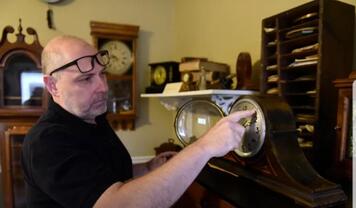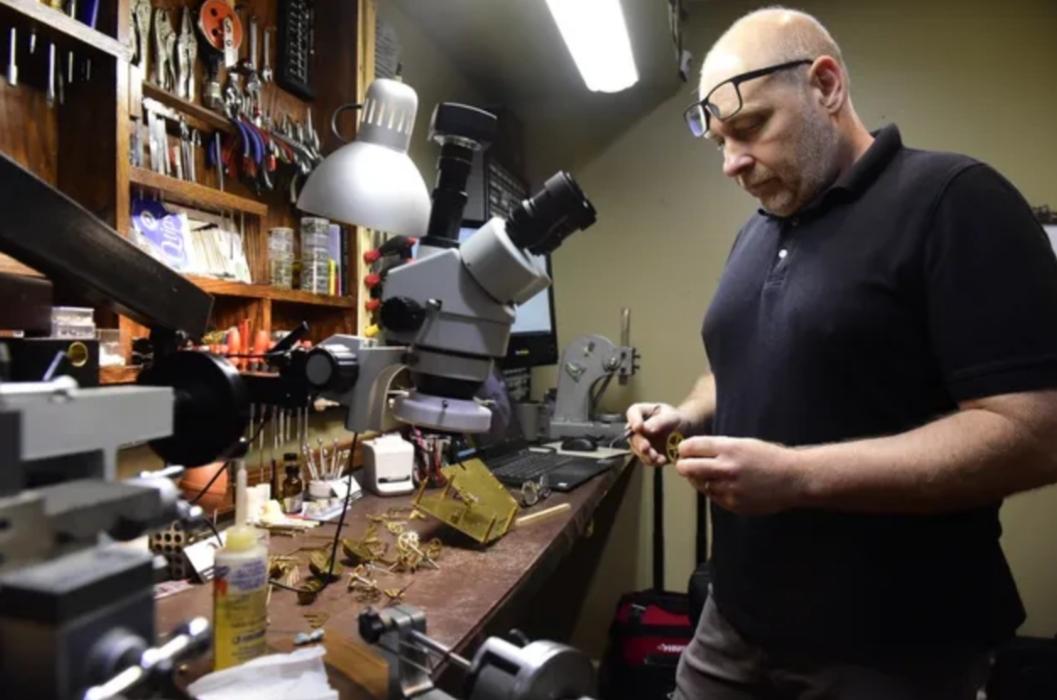
GALION - A dozen clocks ticked and tocked around Steve Shroyer as he opened the glass door of an American time-and-strike.
"Different kinds of clocks need to be adjusted certain ways," he said, slowly moving the minute hand forward.
It's a process millions of people across the world will go through 2 a.m. Sunday when the time falls back an hour, ending daylight saving time until March 8.
Shroyer has been repairing clocks of all types for nearly 15 years. His dad's friend, Doug Osborne, introduced him to the trade when he was a boy. It wasn't until several years into his corporate career that Shroyer realized he might like to work on clocks himself, so he asked his old acquaintance to teach him more about the springs and gears that keep the day moving forward.
"Once I started, it was like finding that thing you were meant for," Shroyer said.
He finally opened Cottage Clock Shop in Galion full time in 2008. He drives as far as Findlay, Sandusky, Wooster and Columbus to repair grandfather clocks or pick up cuckoo or winding clocks in need of cleaning or repair.
"I offer free pickup and delivery," Shroyer said. "Some of my customers are older and can't get out."
He's a breed that's becoming more scarce as time marches forward. He said there are now fewer than 2,000 clock repairmen across the United States. He's one of only a handful in Ohio, and the only one who does it full-time in North Central Ohio.
"It used to be that every little town had one," Shroyer said. "Now I have a bunch of little towns."
Each clock is different Clockwork begins with understanding how the timepiece is powered. Newer clocks are driven by electricity, either from a battery or an electrical chord. But that's a luxury clock makers didn't have hundreds of years ago. Grandfather and cuckoo clocks rely on gravity to keep the time, as weights suspended by chains slowly pull down on the gears that drive their hands forward. Winding clocks are given energy as their springs are wound tight.
The manually powered clocks must either be wound or have their weights lifted on a regular schedule — some daily, others every eight days and the rest every 31 days.
"Before electricity, there were about a half dozen American companies turning out hundreds of thousands of clocks every year," Shroyer said.
The world's foremost clock makers were historically in England, France and Germany, with the latter now being the largest manufacturer on the globe.
American clocks made before the Great Depression are considered antiques, while those made after are considered modern. In Europe, World War II is the barrier between old and new.
Winding clocks with only one winding point are time-only mechanisms that make no noise. Shroyer said it's safe to adjust their time by grabbing the hour hand and moving it backward.
"That's the only one you can do that with," he cautioned.
Clocks with two winding points both keep time and strike at the top of every hour. Those with three places to wind keep time, strike on the hour and chime every 15 minutes. For both of those, Shroyer said it's important to push the minute hand forward 11 revolutions, allowing the hour hand to land in a position that was one hour less than where it started. Moving those hands backward would make the hourly chimes to be out of sync with the time displayed on the clock's face.
Grandfather clocks are designed to be adjusted by moving the minute hand backward one revolution of the dial.
"With a cuckoo clock, you never want to go backward, because you'll loosen the hand nut," Shroyer warned.
For those, he said to flip the lever that turns off the hourly music, grab the middle of the minute hand and wind it forward 11 revolutions.
Common electric wall clocks of all types have a dial on their back that Shroyer said should be spun either forward or backward, whichever way the owner prefers. Those, though, should never be adjusted by touching their hands.
GALION - A dozen clocks ticked and tocked around Steve Shroyer as he opened the glass door of an American time-and-strike.
"Different kinds of clocks need to be adjusted certain ways," he said, slowly moving the minute hand forward.
It's a process millions of people across the world will go through 2 a.m. Sunday when the time falls back an hour, ending daylight saving time until March 8.
Shroyer has been repairing clocks of all types for nearly 15 years. His dad's friend, Doug Osborne, introduced him to the trade when he was a boy. It wasn't until several years into his corporate career that Shroyer realized he might like to work on clocks himself, so he asked his old acquaintance to teach him more about the springs and gears that keep the day moving forward.
"Once I started, it was like finding that thing you were meant for," Shroyer said.
He finally opened Cottage Clock Shop in Galion full time in 2008. He drives as far as Findlay, Sandusky, Wooster and Columbus to repair grandfather clocks or pick up cuckoo or winding clocks in need of cleaning or repair.
"I offer free pickup and delivery," Shroyer said. "Some of my customers are older and can't get out."
He's a breed that's becoming more scarce as time marches forward. He said there are now fewer than 2,000 clock repairmen across the United States. He's one of only a handful in Ohio, and the only one who does it full-time in North Central Ohio.
"It used to be that every little town had one," Shroyer said. "Now I have a bunch of little towns."
Each clock is different Clockwork begins with understanding how the timepiece is powered. Newer clocks are driven by electricity, either from a battery or an electrical chord. But that's a luxury clock makers didn't have hundreds of years ago. Grandfather and cuckoo clocks rely on gravity to keep the time, as weights suspended by chains slowly pull down on the gears that drive their hands forward. Winding clocks are given energy as their springs are wound tight.
The manually powered clocks must either be wound or have their weights lifted on a regular schedule — some daily, others every eight days and the rest every 31 days.
"Before electricity, there were about a half dozen American companies turning out hundreds of thousands of clocks every year," Shroyer said.
The world's foremost clock makers were historically in England, France and Germany, with the latter now being the largest manufacturer on the globe.
American clocks made before the Great Depression are considered antiques, while those made after are considered modern. In Europe, World War II is the barrier between old and new.
Winding clocks with only one winding point are time-only mechanisms that make no noise. Shroyer said it's safe to adjust their time by grabbing the hour hand and moving it backward.
"That's the only one you can do that with," he cautioned.
Clocks with two winding points both keep time and strike at the top of every hour. Those with three places to wind keep time, strike on the hour and chime every 15 minutes. For both of those, Shroyer said it's important to push the minute hand forward 11 revolutions, allowing the hour hand to land in a position that was one hour less than where it started. Moving those hands backward would make the hourly chimes to be out of sync with the time displayed on the clock's face.
Grandfather clocks are designed to be adjusted by moving the minute hand backward one revolution of the dial.
"With a cuckoo clock, you never want to go backward, because you'll loosen the hand nut," Shroyer warned.
For those, he said to flip the lever that turns off the hourly music, grab the middle of the minute hand and wind it forward 11 revolutions.
Common electric wall clocks of all types have a dial on their back that Shroyer said should be spun either forward or backward, whichever way the owner prefers. Those, though, should never be adjusted by touching their hands.
